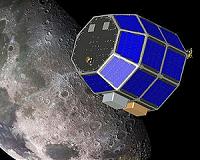 |
Sydney, Australia (SPX) Apr 20, 2010 In 2009, it was found that some polar regions of the Moon are the coldest places in the solar system. It's even colder there than distant, frozen Pluto! Some craters are permanently blocked from sunlight, and apparently lack sources of heat from underground. These areas aren't just cold at certain times. They never get warm at all. The Moon's cold traps have been celebrated for another reason. They apparently hold large quantities of water ice, which could be highly useful to astronauts in the future. Water can be turned into oxygen and rocket fuel, in addition to its uses for drinking and cleaning. Scientists wonder what else lurks in these cold traps. Could there be fragile minerals or organic substances that have been undisturbed for eons? It's possible. In the near future, more missions will be launched to explore these regions. Some of them could even be commercial lunar robots, launched by private companies. We're very focused on what we can get out of the Moon's cold traps, but we haven't focused much on what we could put there. This could be an ideal region to store material that needs to be preserved from catastrophes. On Earth, biologists have prepared "seed banks" of various plants, including agricultural crops. These banks could be used to restore biodiversity to the world if it is devastated by some sort of major catastrophe. Some of these seed banks are in frigid northern regions of the Earth, where the cold, dry conditions help to preserve them. Could a seed bank be launched to the Moon? Admittedly, it's a long way to go, and retrieving the seeds could be difficult. But a lunar seed bank could serve other purposes besides emergency management. It would be interesting to see how the seeds would respond over a long period of time, such as decades. The Moon's temperatures may be too low to allow suitable preservation, and could damage genetic material. There's also the potential problem of the Moon's radiation, which also seems to be more complex than we had previously suspected. Information from these experiments could help with space agriculture and also with research into exobiology and pansperimia theory, which explores the potential transport of living organisms through space. A seed bank could be carried on a simple lander. It could be nothing more than a container, no larger than a soft drink can, filled with seed packages. Its mass would be low. At some point, it would be interesting to carry such an experiment as an auxiliary payload. Burying a seed bank, or several of them, inside the lunar soil would also be interesting. The effects of shielding the packages from radiation would be a useful biological experiment, especially if the depths of burial were carefully calibrated. Some seeds could even be exposed to the vacuum of the lunar surface, to see how they would fare under such harsh conditions! Eventually, a seed bank could be returned to Earth. It could be collected by astronauts, or retrieved by a robot lander. The spacecraft that deposited the bank on the Moon would probably not be the one to return it. Growing the seeds under controlled conditions would be interesting to the public, and practical science. Seed packages flown in space have previously served as excellent outreach projects for schools and young people, teaching them not only science but the importance of spaceflight. Seeds from the Moon could follow on from this trend, at a time when the world needs such projects more than ever. Dr Morris Jones is the author of "The New Moon Race", available from Rosenberg Publishing (www.rosenbergpub.com.au).
Share This Article With Planet Earth
Related Links - Mars News and Information at MarsDaily.com Lunar Dreams and more
 Craters Around Lunar Poles Could Be Electrified
Craters Around Lunar Poles Could Be ElectrifiedGreenbelt MD (SPX) Apr 19, 2010 As the solar wind flows over natural obstructions on the moon, it may charge polar lunar craters to hundreds of volts, according to new calculations by NASA's Lunar Science Institute team. Polar lunar craters are of interest because of resources, including water ice, which exist there. The moon's orientation to the sun keeps the bottoms of polar craters in permanent shadow, allowing temper ... read more |
|
| The content herein, unless otherwise known to be public domain, are Copyright 1995-2010 - SpaceDaily. AFP and UPI Wire Stories are copyright Agence France-Presse and United Press International. ESA Portal Reports are copyright European Space Agency. All NASA sourced material is public domain. Additional copyrights may apply in whole or part to other bona fide parties. Advertising does not imply endorsement,agreement or approval of any opinions, statements or information provided by SpaceDaily on any Web page published or hosted by SpaceDaily. Privacy Statement |